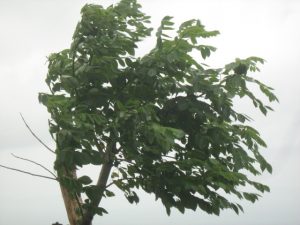 Driving in high winds is much less challenging for those in smaller cars, such as Kias, than those in SUVs and other larger vehicles. It can still be dangerous, however. You share the road with other drivers, after all, and roadside hazards are always a factor. You should take windy driving conditions seriously.
Driving in high winds is much less challenging for those in smaller cars, such as Kias, than those in SUVs and other larger vehicles. It can still be dangerous, however. You share the road with other drivers, after all, and roadside hazards are always a factor. You should take windy driving conditions seriously.
Watch for Larger Vehicles
Even if you’re having minimal difficulties keeping your car in your own lane, other vehicles may not be as fortunate. High-sided vehicles, such as trucks, can easily lose control when hit by a strong gust of wind. Watch for trucks that can’t seem to keep a straight line, and be sure to give them a wide berth. Some truck drivers are better than others, plus their differing rigs and cargo weights can make certain runs more challenging than others.
Be especially vigilant around any RVs and cars or trucks pulling travel trailers. Driving these vehicles doesn’t require a commercial driver’s license, yet they are just as dangerous in high winds as those that professionals drive. Keep an eye out for trailer sway, wandering outside of lanes, and other warning signs.
Stay Alert
Don’t fix your gaze on the car ahead. Instead, constantly monitor your side mirrors and rearview. Most importantly, look for debris on the road’s surface ahead and watch the sides of the road for any branches or other hazards that can enter your path. Check the trees on the side of the road for an indication of how bad the wind is — since it’s easy to lose track when you have all your windows up.
Also be watchful for other drivers. If you see a car or truck that’s struggling to stay in their lane, keep your distance. The best driver in the world can still become involved in an accident if someone else loses control.
Keep Both Hands on the Wheel
This may seem like an obvious one. However, without even thinking about it, we often tend to use one hand to steer and the other to fiddle with controls or hold a coffee cup. A strong gust can easily pull the steering wheel to one side, so always use both hands and keep a firm grip when things get windy.
Slow Down
It’s tempting to speed up so you get to your destination (and the safety it provides) more quickly, but this can be a bad idea. It’s easier to maintain control at lower speeds. Plus, wind can push you from behind, causing unexpected acceleration. You may even consider stopping completely — by finding a safe place to pull over and wait out the storm.
Keep Your Distance
Collisions only occur when someone (or something) gets too close. Avoid the lane that’s closest to the side of the road and the hazards it can introduce. Don’t ride next to other drivers. Instead, adopt a “staggered” pattern in case someone gets blown into a neighboring lane. Try to keep empty space around you on all sides.
Driving in high winds can be hazardous. Stay mindful of other drivers and your surroundings. If you play it safe, you’ll get to your destination in one piece.
Image via Flickr by I_nJ0I






 Warranties include 10-year/100,000-mile powertrain and 5-year/60,000-mile basic. All warranties and roadside assistance are limited. See retailer for warranty details.
Warranties include 10-year/100,000-mile powertrain and 5-year/60,000-mile basic. All warranties and roadside assistance are limited. See retailer for warranty details.